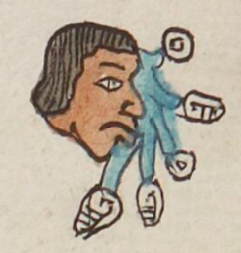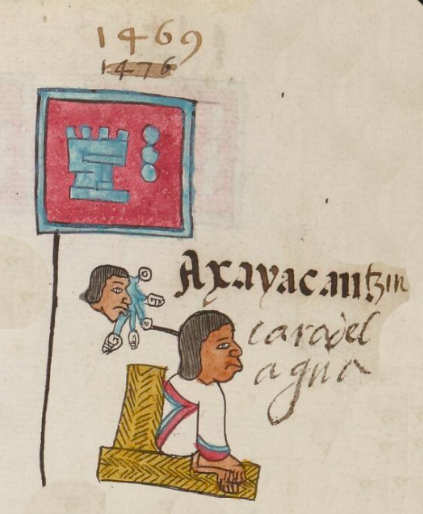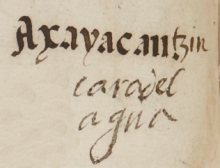Axayacatl (TR34v)
This compound hieroglyph for the personal name Axayacatl, held by a late fifteenth-century Mexica ruler known for imperial expansion, shows the head of a man in profile, looking toward the viewer's right. His eye is open. Running down his face is a stream of water with five short sprays, each one with either a droplet or a turbinate shell at the tip. The water is painted the usual color of turquoise blue.
Stephanie Wood
Some have translated this name as Water Face, but this is also the name of an insect. If the latter is meant, then this glyph is fully phonographic. The Spanish-language gloss was written in two hands, with the reverential suffix (-tzin) added to the name at a later point along with the translation "Face of Water." The contextualizing image shows the rulers seated on a petlatl and icpalli, symbols of his rule. His knees are up, and he is covered with a cape having a red and blue-trimmed diamond shape on his back and the same red and blue trim where the cape meets his feet.
For another rendition of the glyph for Axayacatl, see Marc Thouvenot's vignette about an image from the Códice Matritense de la Real Academia, https://vignettes.sup-infor.com/imagen/5-RA_01_051r_f. In that one, the water curves around the top of the head and spills down over Axayacatl's face.
Stephanie Wood
Axayacantzin
caradel
agua
Axayacatzin, cara del agua
Stephanie Wood
ca. 1550–1563
Jeff Haskett-Wood
Axayacatzin, gobernante, tecuhtli, tecutli, teuctli, tlahtoani, tlatoani, nombres de hombres

a(tl), water, https://nahuatl.wired-humanities.org/content/atl
xayaca(tl), face, https://nahuatl.wired-humanities.org/content/xayacatl
Agua-Cara (o Cara del Agua)
Stephanie Wood
Telleriano-Remensis Codex, folio 34 recto, MS Mexicain 385, Gallica digital collection, https://gallica.bnf.fr/ark:/12148/btv1b8458267s/f94.item.zoom
The non-commercial reuse of images from the Bibliothèque nationale de France is free as long as the user is in compliance with the legislation in force and provides the citation: “Source gallica.bnf.fr / Bibliothèque nationale de France” or “Source gallica.bnf.fr / BnF.”





